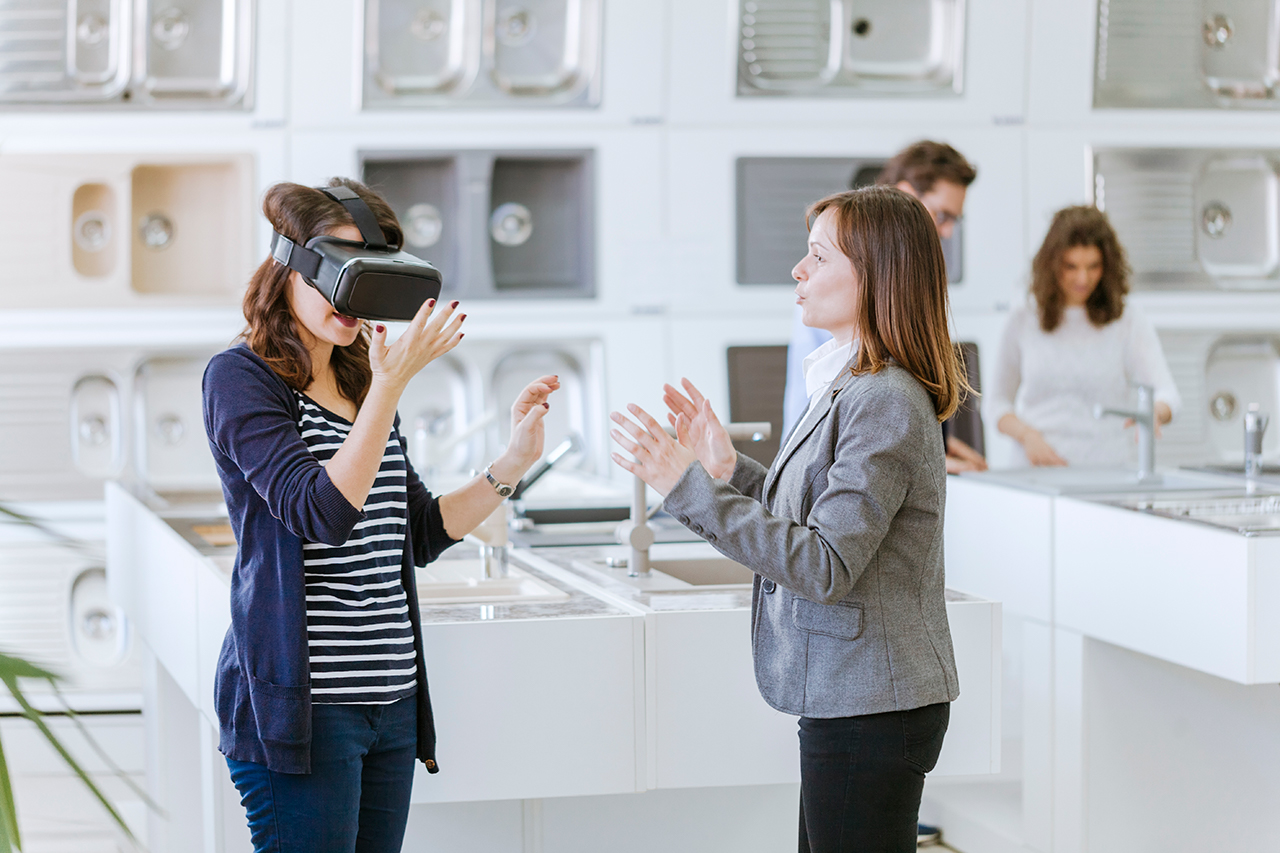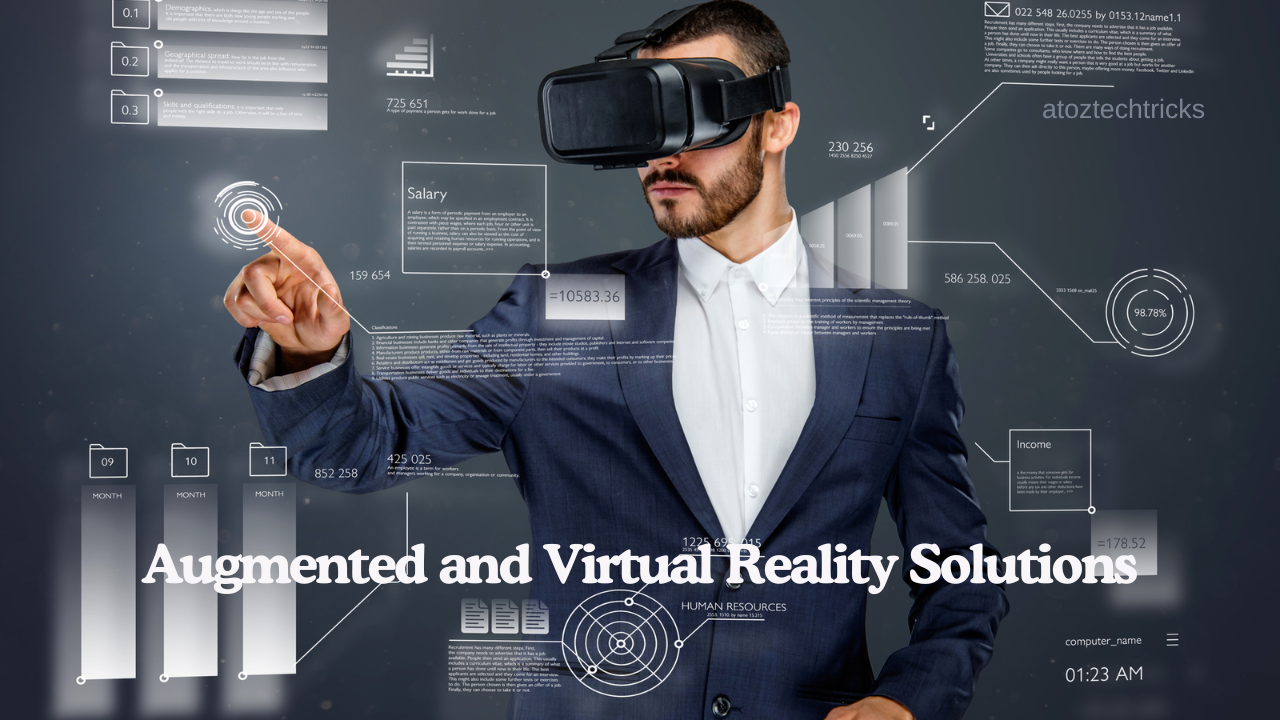Augmented and Virtual Reality Solutions: Transforming the Modern World
Augmented Reality (AR) and Virtual Reality (VR) are rapidly transforming various industries, from entertainment and education to healthcare and business. These immersive technologies offer innovative solutions to enhance experiences, improve learning, and streamline operations. This article delves into the applications, benefits, challenges, and prospects of AR and VR solutions, highlighting their impact on today’s world.
Understanding Augmented and Virtual Reality
What is Augmented Reality?
Augmented Reality overlays digital information onto the real world, enhancing our perception of reality with additional data. This is achieved through devices like smartphones, tablets, and AR glasses, which use cameras and sensors to integrate digital elements into the user’s environment. Unlike VR, which creates a fully immersive experience, AR maintains a connection to the real world.
Examples of AR Applications
- Navigation: AR can provide real-time directions by overlaying navigation prompts on the user’s view of the road.
- Retail: AR apps allow customers to visualize how products will look in their homes before purchasing.
- Education: AR can bring textbooks to life by displaying interactive 3D models and animations.
Technology-Based Business Ideas: Unleashing Innovation for the Future
What is Virtual Reality?
Virtual Reality creates a completely simulated environment that users can interact with through VR headsets and controllers. This technology immerses users in a computer-generated world, often isolating them from the physical world. VR is primarily used for gaming, training, and simulations.
Examples of VR Applications
- Gaming: VR provides an immersive gaming experience by placing players in a 3D world where they can interact with the environment and other players.
- Training: VR is used for training in fields like aviation, medicine, and the military, offering realistic simulations without real-world risks.
- Healthcare: VR helps in pain management, exposure therapy, and surgical training by creating controlled environments for therapeutic practices.

Key Benefits of AR and VR Solutions
Enhanced User Experience
AR and VR provide unique and engaging user experiences that traditional media cannot match. AR enhances real-world interactions, making them more informative and interactive. VR, on the other hand, offers an escape from reality, allowing users to experience things that would be impossible in the physical world.
- Interactive Learning: AR and VR create interactive learning environments, making education more engaging and effective.
- Entertainment: Both technologies offer new forms of entertainment, from immersive gaming experiences to virtual concerts and events.
Improved Training and Simulation
AR and VR offer significant benefits in training and simulation, providing safe and controlled environments for practice and learning. This is particularly valuable in high-risk professions where real-world training could be dangerous or costly.
- Medical Training: VR simulations help medical professionals practice surgical procedures and diagnose conditions in a risk-free environment.
- Industrial Training: AR can guide workers through complex assembly processes with step-by-step instructions overlaid on their view.
Enhanced Marketing and Customer Engagement
In marketing, AR and VR create memorable and engaging experiences that can drive customer interest and sales. These technologies allow businesses to showcase their products and services in innovative ways.
- Virtual Try-Ons: Retailers use AR to let customers try on clothes, accessories, or makeup virtually, enhancing the shopping experience.
- Virtual Tours: Real estate agents and travel companies use VR to offer virtual tours of properties or destinations, helping customers make informed decisions.
Home-Based Daycare or Babysitting Services: A Comprehensive Guide
Applications Across Different Industries
Healthcare
AR and VR are revolutionizing healthcare by offering new ways to diagnose, treat, and manage conditions.
- Surgical Training: VR simulations provide a risk-free environment for surgeons to practice and refine their skills.
- Pain Management: VR is used to distract patients from pain during medical procedures, offering a non-pharmacological approach to pain relief.
- Physical Therapy: AR and VR can create interactive exercises for patients undergoing physical therapy, making the process more engaging and effective.
Education
The education sector benefits greatly from AR and VR, offering immersive learning experiences that enhance understanding and retention.
- Interactive Lessons: AR can turn textbooks into interactive 3D models, making complex subjects easier to understand.
- Virtual Field Trips: VR allows students to explore historical sites, scientific phenomena, and distant locations without leaving the classroom.
Business and Industry
Businesses use AR and VR to improve operations, enhance training, and engage customers.
- Product Design: AR allows designers to visualize and interact with prototypes in real time, speeding up the design process.
- Remote Assistance: AR enables remote experts to assist field technicians by overlaying instructions on their view, reducing downtime and errors.
Entertainment and Gaming
The entertainment industry leverages AR and VR to create new forms of interactive content.
- Immersive Gaming: VR games provide a fully immersive experience, transporting players to fantastical worlds.
- Enhanced Reality Experiences: AR adds layers of digital content to real-world environments, creating interactive experiences in games and media.
Challenges and Limitations
Technical Limitations
Both AR and VR technologies face technical challenges that impact their performance and user experience.
- Hardware Limitations: High-quality AR and VR experiences require advanced hardware, which can be expensive and cumbersome.
- Latency Issues: Latency in VR can cause motion sickness and disrupt the immersive experience. Reducing latency is crucial for a smooth experience.
Privacy and Security Concerns
The use of AR and VR raises privacy and security concerns, particularly regarding the data collected by these technologies.
- Data Privacy: AR and VR devices often collect sensitive information about users, such as their physical environment and interactions. Ensuring this data is protected is essential.
- Cybersecurity Risks: VR platforms can be vulnerable to cyberattacks, including data breaches and unauthorized access to user information.
Accessibility and Cost
The cost and accessibility of AR and VR technologies can be barriers to widespread adoption.
- High Costs: Advanced AR and VR systems can be expensive, limiting their accessibility to certain demographics or industries.
- Accessibility Issues: Some users may have difficulty using AR and VR due to physical or cognitive impairments, making it important to design inclusive solutions.

The Future of AR and VR Solutions
Advancements in Technology
The future of AR and VR will be shaped by continued advancements in technology, including improvements in hardware, software, and user interfaces.
- Enhanced Hardware: Future AR and VR devices will likely become more lightweight, comfortable, and affordable, making them accessible to a broader audience.
- Improved Software: Advances in software will enable more realistic and interactive experiences, with better integration of AI and machine learning.
Integration with Emerging Technologies
AR and VR will increasingly integrate with other emerging technologies, creating new possibilities and applications.
- Artificial Intelligence: AI will enhance AR and VR experiences by enabling more intelligent interactions and adaptive environments.
- 5G Connectivity: The rollout of 5G networks will improve the performance of AR and VR applications by providing faster and more reliable connectivity.
Personal Shopping and Styling Services: A Comprehensive Guide
Expansion into New Industries
As AR and VR technologies continue to evolve, they will find applications in new and emerging industries.
- Real Estate: VR will enable virtual property tours and design visualizations, revolutionizing the real estate market.
- Manufacturing: AR will streamline manufacturing processes by providing real-time information and guidance to workers on the production floor.
Augmented and Virtual Reality solutions are transforming various aspects of modern life, from education and healthcare to entertainment and business. These technologies offer unique benefits, including enhanced user experiences, improved training, and innovative marketing strategies. However, they also face challenges related to technical limitations, privacy concerns, and accessibility issues. As technology continues to advance, AR and VR will play an increasingly significant role in shaping the future, offering new opportunities and solutions across diverse industries. Embracing these technologies and addressing their challenges will be crucial in harnessing their full potential and driving innovation in the years to come.





Post Comment